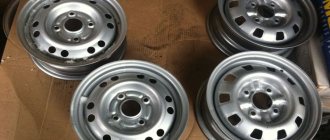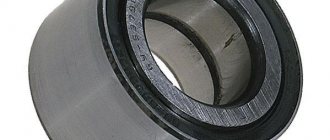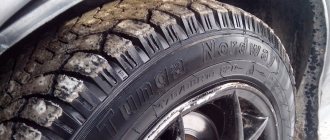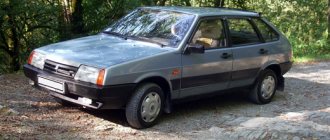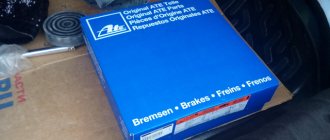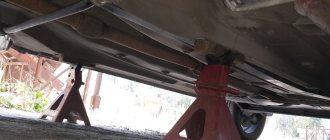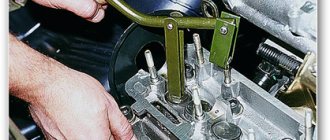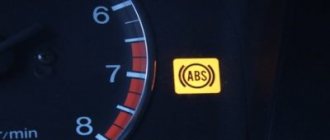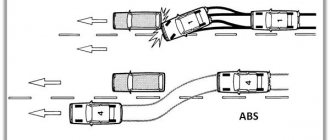During the life tests of Vesta, wheel caps were constantly lost. Owners of the Lada XRAY crossover and other Lada models also face a similar situation. Is it worth buying decorative plugs for the front wheel hubs in case of loss? Or drive on, not paying attention to their absence?
The opinion of car enthusiasts is divided on two fronts:
- Some believe that these caps are only decorative.
- Others believe that they also protect the threads from the external environment, preventing rust and souring.
The rear hubs have metal caps of a different diameter (they will not fit the front wheels). The rear plugs, unlike the front ones, sit in place quite tightly and do not get lost during operation. Sometimes they are even coated with graphite lubricant so that there are no problems when removing them if necessary.
Perhaps there would be less controversy on this topic if the price of the front caps for alloy wheels were within reasonable limits. The cost of these accessories from the dealer is about 100-150 rubles apiece.
| Model LADA | Wheel rim | Catalog number | Hub hole diameter, mm |
| Lada Vesta | stamped disc | 7700302762 (black plastic) | 50 |
| alloy wheel 15″ | 8450008632 (Anna) | ||
| alloy wheel 16″ | 8450008636 (Ptalomey), 8450030707 (Phoenix) | ||
| Lada XRAY | stamped disc | 7700302762 (black plastic) | |
| alloy wheel 15″ | 403153662R (Solenza) | ||
| alloy wheel 16″ | 403153662R (Kanjara) | ||
| Lada Largus | stamped disc | 7700302762 (black plastic) | |
| Cast drive | 403153662R | ||
| Lada Granta/Kalina/Priora | stamped disc | 2110-3103065 (black plastic) | |
| Cast drive | 2172-3101014 |
The diameter of the hub hole on Lada Vesta, Largus and XRAY is 50 mm (and some Renault models). That is, the wheel caps of these cars are interchangeable.
Problem
Car owners have long noticed that the front wheels of the Lada Vesta are not equipped with hub caps. When equipped with light alloy wheels, this point is of little significance, since alloy wheels have caps, but standard ones do not have them. Moreover, this applies only to the front pair of wheels, since Vesta has rear hub caps.
This issue is especially relevant in winter, since on the eve of the winter season, drivers change tires, and not everyone puts back alloy wheels, because many prefer to simply install standard steel ones and ride on them all winter.
There are no front wheel hub caps on Vesta from the factory
As a result, dirt, snow, dust, etc. are constantly flying onto the hub bolts, which are completely open. In general, there is nothing catastrophic in this, but it is also unpleasant to look at such a picture. Yes, and difficulties with unscrewing the hub nut may also arise if it becomes necessary to remove the hub.
Consequences of water accumulation in the body or interior
Water in the body and interior is dangerous not only for car parts, but also for the people who operate the vehicle. The most common consequences are listed below:
- The prolonged presence of water in the internal cavities of the car leads to the formation of corrosion of body parts. If nothing is done, the car will begin to rot.
- Moisture in the interior causes mold and mildew to develop in the interior. If the cause is not eliminated, the upholstery will become unusable.
- Accumulated water in the cabin in the summer is an excellent habitat for various pathogenic bacteria. In a warm and humid place they spread quickly and can cause illness in the person using the car.
- In the off-season in urban conditions, it is not water that gets into the car, but brine from reagents. This is the cause of the development of allergies, especially in children.
- Water that accumulates under the windshield and enters the heater air intake can cause a short circuit in the wiring.
- Also, water from under the windshield accumulates on the filter, where bacteria multiply. When you turn on the stove, all bacteria scatter throughout the cabin. People in the car breathe it. Such bacteria can cause rapid pneumonia or severe bronchitis.
You can learn how to clean the drainage holes from the video:
There should be no water present in the cavities of the car at all. This should not be taken lightly. Even a small amount of moisture over a long period can turn your favorite vehicle into a rotten trough that no one will buy in the future.
2.1.6. Body care
| GENERAL INFORMATION |
Threshold drainage holes
Door drainage holes
The body is the basic and most expensive element of a car. It is made of modern materials and protected from corrosion by high-quality protective agents. The basis for the durability of corrosion protection is laid by the manufacturer, but its effectiveness and duration depend on proper care, climatic conditions, the ecological state of the environment and storage conditions.
To avoid scratches on the paintwork of the body, do not remove dust and dirt with a dry wipe. It is better to wash the car before the dirt dries with a low-pressure stream of water using a soft sponge. In summer, wash your car outdoors in the shade. If this is not possible, then immediately wipe the washed surfaces dry, since when drops of water dry in the sun, stains form on the painted surface. In winter, after washing the car in a warm room before leaving, wipe the body and door seals dry, since freezing of the remaining drops may cause cracks in the paintwork and freezing of the door seals. It is not recommended to use soda and alkaline solutions, as well as waste water, to wash the car so that the coating does not fade.
Where can I buy?
To make a purchase, you can go to either the LADA dealership or any auto store. However, these elements are not always available. Therefore, the easiest way would be to order them online.
The table shows resources where you can place an order.
Online store
Price, rub.)
It is worth noting that the diameter of the hub hole of the Lada Vesta is 50 mm, which is similar to that of the Lada X-Ray, Largus, as well as some Renault models. All this allows you to find products with the lowest price when choosing.
Also, when choosing between plastic and stainless steel Vesta wheel hub caps, it is recommended to give preference to plastic products, since they “sit” more tightly on the wheel.
Stainless steel cap
How moisture accumulates in a car
She gets there in several ways:
- The first way moisture gets in is the absence of rubber plugs in the lower part of the body that cover the drainage holes. Any trip in the rain will result in water in the lower parts of the body.
- Sunroof. A poorly closed sunroof during rain or car washing will also lead to water in the cabin. The rubber bands that seal the hatch can dry out from age, so water can seep through them.
- If the trunk seal is not doing its job, water will accumulate under the spare tire.
- Another way water forms in body cavities is through condensation. But in order to harm the car, there must be a lot of condensation, and it forms only under certain conditions.
- Water also gets into the car when the drain holes under the windshield are clogged. Rainwater is collected like in a bathtub and poured into the air intake of the stove. Through the filter it enters the passenger compartment on the passenger side.
All car enthusiasts are well aware of how water affects body parts. In those places where water stagnates, rust forms, and then corrosion. If nothing is done, the car will rot from the inside.
Where are the drainage holes located?
Drainage holes are located in the lower part of the body. There are small holes at the bottom of each door (including the trunk). Photo: drive2.ru
Some of them are closed with a rubber seal, while others are closed with small rubber plugs. These are the drainage holes on the doors.
There are also drainage holes at the bottom of the thresholds. The largest drain is located in the trunk under the spare tire. It is located in the center. There are smaller drains in the side compartments of the trunk. There are drainage holes under the windshield in the body that are supposed to drain water from the wipers.
Here you will find detailed information about the presented Maybach Ultimate Luxury
You will learn about the features of checking a car through the automobile registry of pledges from this material.
How often should drain holes be checked?
As a rule, holes should be checked at least twice a year - in spring and autumn. In the fall - a must! But if this happens, the driver drove along shallow rivers or deep puddles, then the car must be checked immediately after the trip.
Not all drainage holes are sealed with plugs. Small ones are left open specifically to allow moisture to drain. But such holes are also worth checking, as they can become clogged with dirt, dust, leaves and not perform their function.
How to tell if the drain holes are not working
There are several signs that can help you determine that there is something wrong with your drainage holes.
- Wet floor in the cabin after every rain.
- Spread of mold and mildew throughout the lower part of the cabin.
- Unpleasant, musty smell.
- Fogging of windows at any time of the year and in any weather, despite the fact that the stove cannot cope.
- Strange squelching sounds when driving that shouldn't exist.
- Excessive spread of corrosion throughout the lower parts of the body.
- Water in the passenger's feet during rain or after washing.
- The smell of mustiness and rot after turning on the stove.
Installation
After purchasing the Lada Vesta wheel hub caps, all that remains is to install them. However, this will take much longer than it initially seems. The fact is that the installation is hampered by the wheel bolts, due to which the edges of the caps do not fit. For this reason, you have to jack up the wheel, unscrew the bolts a little (but not completely) and put the caps under them, and then tighten the bolts again.
There are different opinions regarding the need for lubrication. Some believe that this is useless, while others are sure that without lubrication, the heat will cause the caps to stick to the discs. As for the lubricant itself, ideally you should use copper, as it provides the optimal effect. But another composition will do.
Body drainage holes
Condensation may form in the internal cavities of the body. To prevent moisture from causing corrosion, drainage holes are provided in the car body. Over time, they can become clogged with dirt. Check the condition of the drainage holes regularly (preferably after each wash) and clean them if necessary.
There are two drainage holes at the bottom edge of each door. To clean them, remove the edge of the rubber seal. The drainage holes in the trunk lid are also located at the bottom edge.
Regularly check the drainage holes in the engine compartment, which are located around the edges:
Rubbing body parts
To increase the life of the rubbing parts of the body, they should be lubricated at every maintenance. If creaks or jamming are detected, the body fittings must be cleaned before lubrication.
Lubricate the rubbing parts of the doors
:
- Side door hinges (silicone spray lubricant).
- Door limiter rods (silicone lubricant in aerosol packaging).
- Driver's door lock cylinder (silicone lubricant in aerosol packaging).
- Door locks (silicone spray lubricant).
Lubricate the hood
:
- Hood hinges (silicone spray lubricant or motor oil).
- Hood latch (silicone spray lubricant or motor oil).
Lubricate the trunk lid
:
- Trunk lid hinges (silicone spray lubricant).
- Trunk lid lock cylinder (silicone lubricant in aerosol packaging).
- Trunk lid lock (spray silicone lubricant or motor oil).
Lubricate other body parts
:
- Hinges of the gas tank filler hatch (silicone aerosol lubricant or motor oil).
- Windshield wiper arm joints (silicone aerosol lubricant). Cover the glass with paper.
- Exterior mirror bracket hinges (silicone spray lubricant).
